A brief history of software licensing
About: Licenseware specializes in license analysis automation and development to get licensing insights, from any data source, in minutes. Find out more about delivering better services on our website 👈
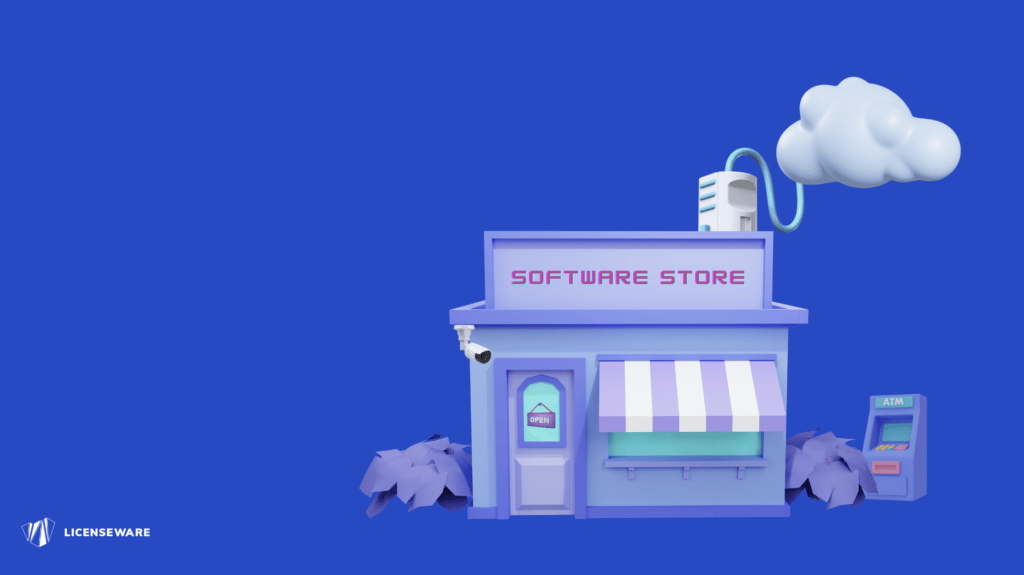
Modern companies can’t exist without software. It is ingrained in the fabric of our societies, and everything depends on it to operate. From critical infrastructure, to communication, to transportation, to entertainment. Everything is organised and controlled by this software layer.
While intangible, software has become a critical and extremely valuable asset for any organisation using it to operate in day to day society. But the software realm is governed by licensing models and rules designed that tell you under which conditions the software can be used. Simply put licensing is the legal agreement that governs the use of software. It outlines the terms and conditions under which the software can be used, including any restrictions on how it can be used, how many users can use it, and for how long it can be used.
Software licenses can be proprietary, meaning that the software is owned by a specific company and is only licensed for use, or they can be open-source, meaning that the software is freely available for use, modification, and distribution.
According to data from various research firms, the global software market was valued at around $1 trillion in 2020 and is projected to reach around $1.5 trillion by 2023. The market is expected to continue to grow at a significant rate in the coming years due to the increasing demand for software in various industries and the ongoing digital transformation of businesses.
It is difficult to provide an exact number of distinct software titles that exist as new software is constantly being developed and released, and older software becomes obsolete or is no longer actively maintained. However, there are a large number of software titles available for various purposes, including operating systems, productivity tools, video games, and specialized software for specific industries. It’s a rough estimate that there are millions of distinct software titles that have been developed and released over the years, and the number continues to grow as new software is created.
All of it is licensed and governed by a distinct license agreement. And a good part of it is Enterprise Software which is high value (it costs millions to license), and risk (users are commonly audited by software companies). Imagine the complexity of managing all that.
How did we get here? And why is licensing so important?
Brief history
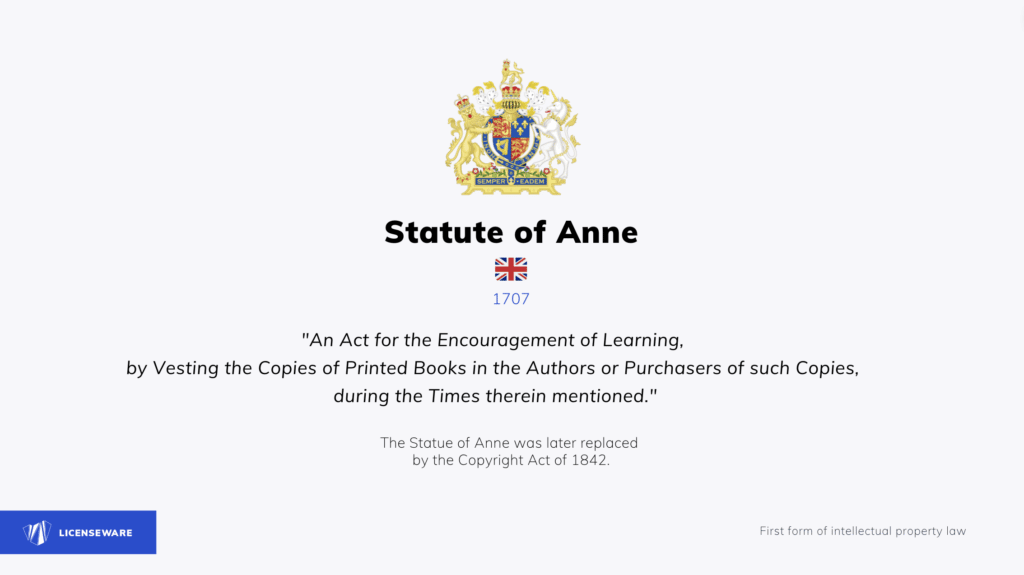
The Statute of Anne, also known as the Copyright Act 1710, was the first copyright law in the English-speaking world. It was passed by the British Parliament in 1710 and went into effect on April 10, 1710. The law granted authors the exclusive right to publish and sell their work for a period of 14 years, with the option to renew for an additional 14 years if the author was still alive.
The reasoning behind the Statute of Anne was to balance the interests of authors, who were seen as the creators of valuable works, with the interests of the public, who would benefit from the dissemination of those works. The law aimed to encourage the production of new literary works by granting authors a temporary monopoly on the sale and distribution of their work, while also ensuring that the public would have access to those works after the copyright expired.
It also aimed to address the issue of book piracy which was a prevalent problem in the time of the statute being passed. The Statute of Anne was seen as a way to provide legal protection for authors and publishers and to help them to earn a living from their work, while also promoting the spread of knowledge and the advancement of learning.
This later evolved and expanded to other industries all over the world. The reasoning was simple, if there’s a no incentive to create original works or innovate, there’s going to be less and less innovation. Society starts degrading. In a world where intelectual property (IP) works can be freely copied and distributed and sold without consequence, there is little to be gained as a creator.
Types of Intelectual Property laws
There are several different types of intellectual property (IP) laws that protect different types of creative or inventive works. The main types of IP laws include:
- Copyright law: Copyright law protects original works of authorship, such as literature, music, and art. It grants authors the exclusive right to reproduce, distribute, and display their work for a certain period of time.
- Patent law: Patent law protects inventions and discoveries, such as new products or processes. It grants inventors the exclusive right to make, use, and sell their invention for a certain period of time.
- Trademark law: Trademark law protects branding and logos that are used to identify and distinguish goods and services. It grants trademark holders the exclusive right to use their trademark in connection with their goods or services.
- Trade secret law: Trade secret law protects confidential business information, such as formulas, recipes, and methods. It prevents others from using or disclosing that information without permission.
- Industrial Design law: Industrial Design law protect the visual design of objects that are not purely functional. It grants exclusive right to the creators to use, manufacture, and sell the design.
- Plant variety protection law: Plant variety protection law protects new varieties of plants. It grants exclusive rights to the creators to use, propagate, and sell the protected variety.
These laws vary depending on the jurisdiction, and some countries may have different laws or variations of these laws that protect other types of intellectual property.
Where does software licensing fit in?
Software licensing falls under the category of copyright law, as software is considered to be a type of literary work. Copyright law grants authors of software the exclusive right to reproduce, distribute, and display their work for a certain period of time. Software licenses are agreements that govern how the software can be used, and they are typically created to allow others to use the software in specific ways, while also protecting the rights of the software’s creators.
What is a software license?
A software license is a legal agreement between the developer or publisher of the software and the user, that outlines the terms and conditions under which the user can use the software. It may include restrictions on how the software can be used, how many users can use it, and for how long it can be used.
Software licenses can take many forms, such as proprietary licenses, which restrict the user’s ability to modify or distribute the software, or open-source licenses, which allow users to view, modify, and distribute the source code. Some software is freely available and can be used without any restriction, while others require the user to purchase a license or pay a subscription fee to use it.
In short, software licensing is basically, a way to allow others to use the software while still protecting the rights of the creators.
Copyright vs. Copyleft
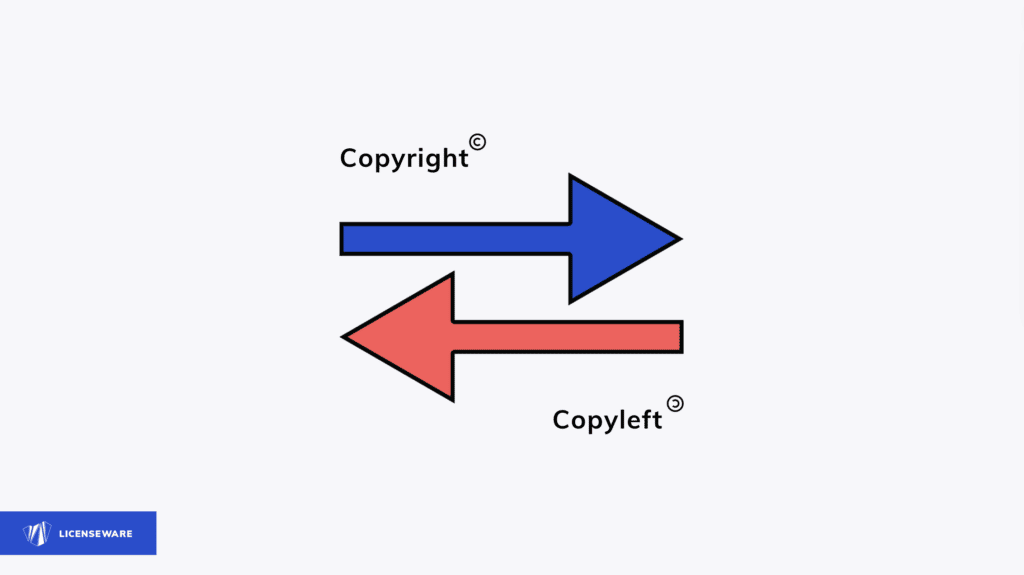
Copyright and copyleft are both forms of intellectual property law, but they operate in very different ways.
Copyright is a legal framework that grants authors the exclusive right to reproduce, distribute, and display their work for a certain period of time. Copyright applies to a wide range of creative works, including literature, music, art, and software. Copyright holders have the right to control how their work is used, and they can license or sell their rights to others.
Copyleft, on the other hand, is a form of licensing that allows users to freely use, modify, and distribute a work, but with the condition that any derivative works must also be made available under the same terms. Copyleft is often used for software and other forms of creative works that are distributed in digital form. The most common form of copyleft is the General Public License (GPL), which is widely used in the open-source software community.
In simple terms, copyright is a system that grants exclusive rights to authors, while copyleft is a system that allows users to freely use, modify and distribute a work with the condition of making derivative works available under the same terms.
The first software license
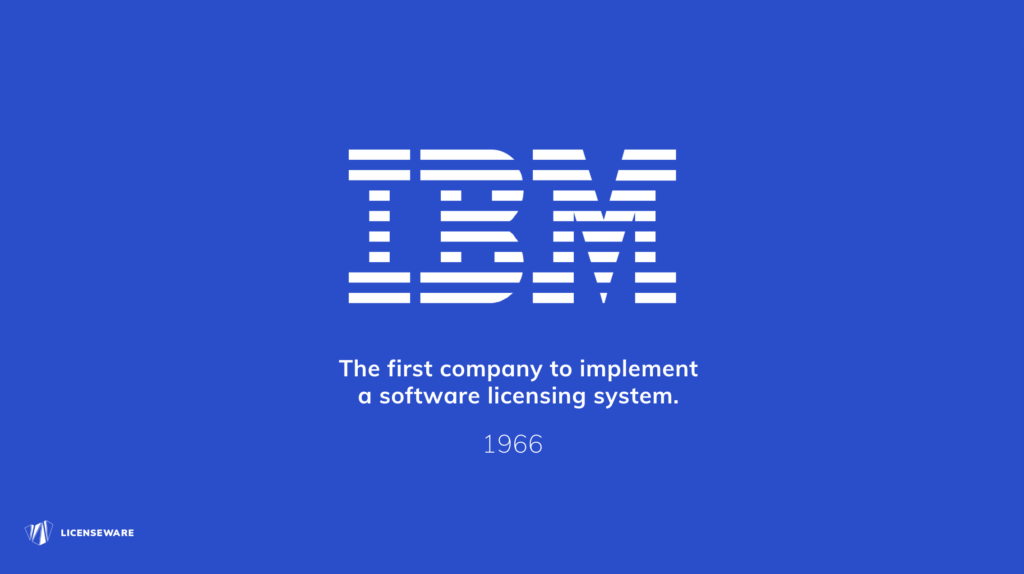
The history of software licensing dates back to the early days of computer technology, when software was primarily developed and used by government organizations and large corporations. The first software licenses were simple agreements between the software developer and the customer, outlining the terms of use and any restrictions on the software.
One ex-IBM engineer, W.S. Humphrey, recounts his journey in a memoir. He remembers being a part of the process of “software unbundling”, the separation of hardware from software, and a task force established in 1966 to bring this vision to reality. (Source)
In the early days, hardware and software were distributed as one, and software was not yet recognized as a protectable subject-matter in the United States, being unfixed and intangible. But the task force saw the potential for copyright as a form of protection for this new and unique separation. The challenge was that it was vulnerable to the concept of exhaustion through “sales” of the software.
This realization led to the creation of a contractual mechanism, to ensure that IBM users would be licensees of software, and not owners. In this way, they could protect this new and intangible subject-matter, in a constantly evolving technological landscape.
In the 1970s and 1980s, as personal computers became more widely available, the software industry began to evolve and expand. Software companies started to develop and market their own software for these personal computers, and licensing agreements became more complex. This is when the concept of proprietary software emerged in the mainstream, where the source code was kept secret and the software was sold commercially.
Proprietary licensing vs. Open Source licensing
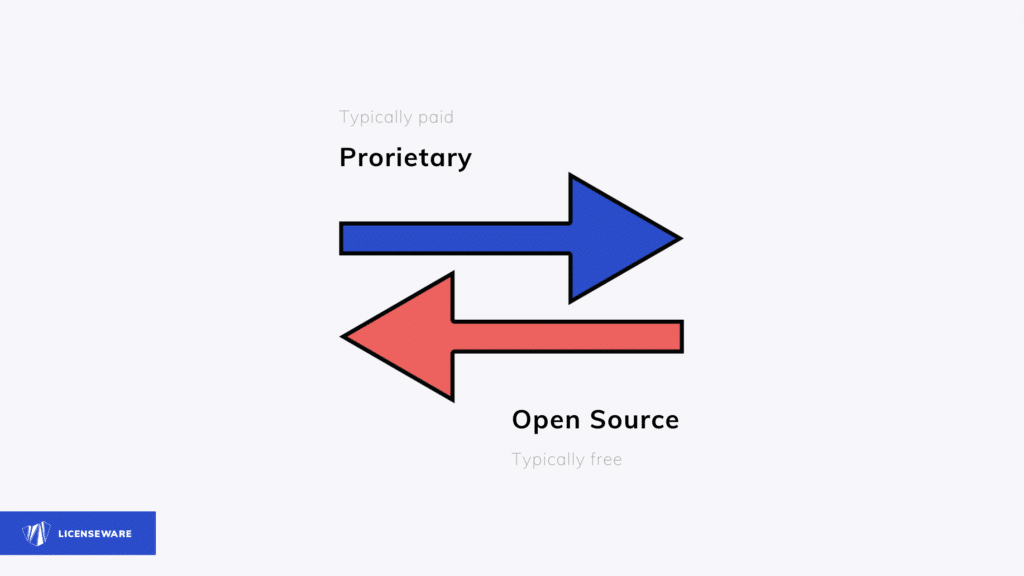
In the 1990s, the Free Software Foundation introduced the concept of open-source software, which made the source code of a software freely available to anyone. This led to the development of the open-source software movement and the creation of the GNU General Public License (GPL), which is a widely-used open-source software license.
Proprietary software licenses are those that restrict the use, modification, and distribution of the software to only the person or entity that has licensed the software. This means that the source code of the software is not available to the public, and the software cannot be modified or distributed without the permission of the copyright holder.
On the other hand, open-source software licenses allow anyone to use, modify, and distribute the software without restriction. The source code of the software is available to the public, and individuals and organizations are free to modify and distribute the software as they see fit.
Simply put, proprietary software is like a fancy sports car that you can only drive if you have the keys, while open-source software is like an alternative means of transportation that anyone can ride. With proprietary software, you’re limited in where you can go and what you can do with it, but you have the assurance that it receives the proper care. With open-source software, anyone can use it, but there’s less control over who’s using it and for what purpose, and it’s dependant on the community to care fore it.
Proprietary pricing vs. Subscription pricing
Proprietary license models and subscription-based license models are both types of software licensing models, but they differ in how they allow customers to use and pay for software.
Proprietary license models have been the norm up to the early 2000s. Proprietary license models are those in which customers purchase a one-time license to use the software. They can use the software indefinitely, but they do not receive any updates or technical support unless they purchase additional licenses. This means that the customer has the right to use the software as long as they want, but they are not guaranteed to get any updates, security patches or technical support.
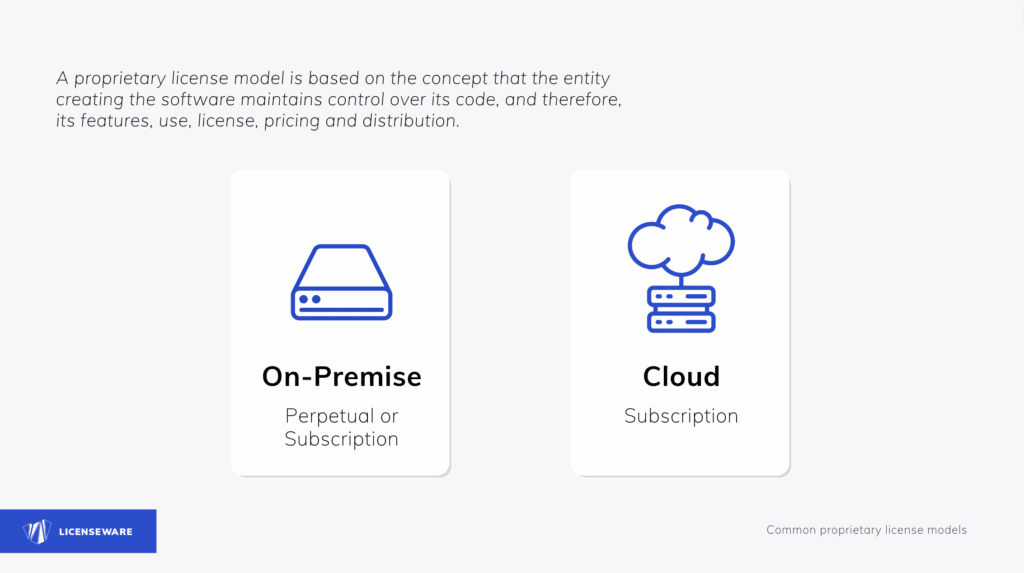
In the early 2000s, software as a service (SaaS) emerged and became increasingly popular, which led to the development of subscription-based licensing models. Subscription-based license models, require customers to pay a recurring fee (usually on a monthly or annual basis) to continue using the software. In exchange, they receive access to the latest updates, security patches, and technical support. Subscription-based license models can be seen as a service, where the customer is paying for the right to use the software and get the support they need.
In summary, proprietary license models are a one-time purchase, and the customer owns the software and has the right to use it indefinitely. Subscription-based license models are a recurring payment, and the customer is paying for the right to use the software and receive support, updates and security patches.
Today, software licensing continues to evolve and adapt to new technologies and business models. Cloud computing, mobile devices, and the Internet of Things have all had an impact on the way software is licensed and used. Software licenses now often include usage-based models, multi-user licenses, and more flexibility for users.
Open Source license models

There are several open source license models, the most common include:
- GNU General Public License (GPL): This is one of the most popular open source licenses, and it requires any derivative works to also be released under the GPL. This license is often used for software programs such as the Linux operating system.
- MIT License: This is a permissive open-source license, that allows others to use, copy, modify, and redistribute the software for any purpose, with or without attribution.
- Apache License: This is another permissive open-source license, similar to the MIT license, allows others to use, copy, modify, and redistribute the software for any purpose, but also requires that the original copyright and license notice be included in any copies of the software.
- BSD license: This license allows others to use, copy, modify, and redistribute the software for any purpose, without having to provide attribution or release their own software under the same license.
- Creative Commons licenses: These licenses are used for content such as text, images, and music, rather than software, and allow the content to be shared and used under certain conditions.
- The Mozilla Public License (MPL): This is a copyleft open-source license that allows others to use, modify, and redistribute the software, but also requires that any changes to the software must be released under the same license.
Each open source license comes with its own terms and conditions, and it’s important to understand the implications of using a particular license before incorporating open-source software into a project.
Can Open Source companies still earn money?
There are several ways that open source software companies can earn money from customers while keeping the software open source:
- Support and maintenance: Open source software companies can offer support and maintenance services, such as troubleshooting and bug fixing, to customers who use their software. These services can be offered on a subscription or pay-per-incident basis.
- Consulting and Training: Open source software companies can also offer consulting and training services to help customers with the implementation, customization, and integration of their software. This can include on-site consulting, remote support, and training classes.
- Proprietary Add-ons: Open source software companies can also develop and sell proprietary add-ons or extensions to the open source software. These add-ons can provide additional functionality, such as increased security or scalability, which can be sold at a premium price.
- Cloud Services: Open source software companies can also provide cloud-based services that are built on top of their open source software. These services can include hosting, data storage, and analytics, and can be sold on a subscription basis.
- Certification: Open source software companies may also offer certifications for their software, which can be used to demonstrate expertise in using and administering the software. These certifications can be sold to individuals or organizations.
- Advertising: Some Open source companies include advertising on their website or in their product to generate revenue.
By offering these services, open source software companies are able to generate revenue from their customers while still providing the underlying software under an open-source license. This allows customers to use, modify, and distribute the software as they see fit, while still providing a way for the open-source software companies to earn money from their products and services.
A very good example of a profitable Open Source software company is Red Hat. Red Hat is a company that specializes in distributing and providing support for open-source software, particularly the Red Hat Enterprise Linux (RHEL) operating system. Despite the fact that the software is open-source and freely available, Red Hat is able to earn money from customers by offering a variety of services and support options.
License control methods
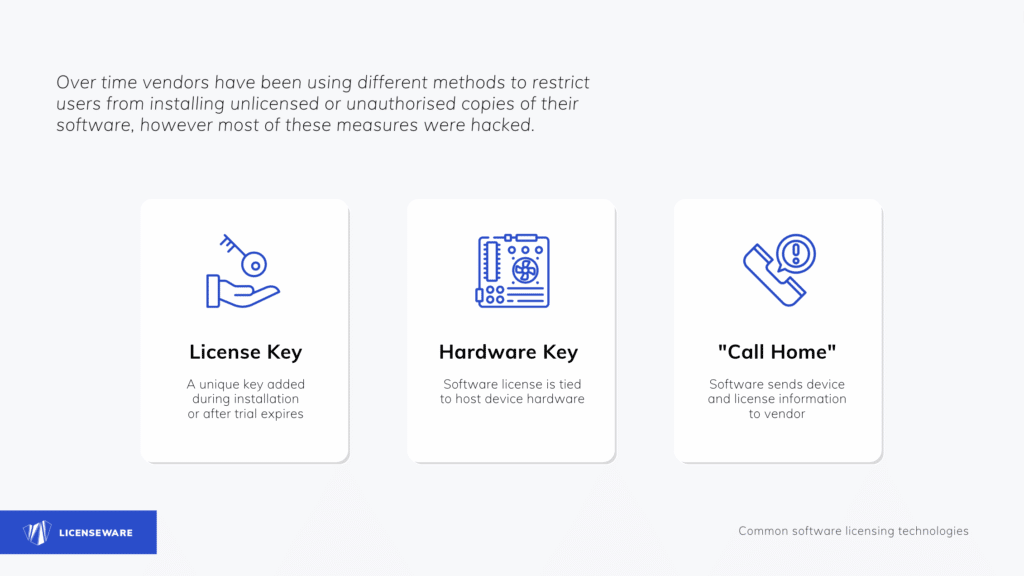
Over time vendors have been using different methods to restrict users from installing unlicensed or unauthorised copies of their software, however most of these measures were hacked.
There are several methods that software vendors use to control the use of their software, including:
- Product keys or license keys: These are unique codes that are provided to customers when they purchase the software. The customer must enter the key during the installation process in order to activate the software.
- Hardware key licensing, also known as “hardware-locked” or “hardware-bound” licensing. This method ties the software license to a physical component of the user’s computer, such as the motherboard, hard drive or network card, making it difficult for the software to be used on other devices. The license is bound to the unique hardware ID of the component and the software will only run if that specific hardware is present. This method ensures that the software is only used on the intended device and makes it more difficult to copy or share the software illegally.
- Time-limited demos: This is a version of the software that is provided to customers for a limited period of time, after which the software will stop working unless a license is purchased.
- Concurrent user licensing: This limits the number of users who can use the software at the same time.
- Node-locked licensing: This ties the software to a specific device or machine, so it cannot be used on any other device.
- Floating licensing: This type of licensing allows a specific number of users to access the software simultaneously, but the users are not tied to specific devices.
- Subscription-based licensing: This is a method where customer pay for access to the software for a certain period of time, and the license will expire when the subscription ends.
- Dongle-based licensing: This is a physical device that is required to be plugged into the computer in order to use the software.
- The “Call Home” method: This method involves the software periodically sending information about the user and their computer back to the vendor’s server, in order to verify that the license is being used correctly. The information sent may include details such as the hardware configuration of the computer, the version of the operating system, and the IP address of the device. This method allows the vendor to monitor the usage of their software and ensure that the license terms are being adhered to. If the vendor detects any suspicious or illegal activity, such as the software being used on multiple devices or being distributed without a license, they can take action to revoke the license or take other measures to protect their intellectual property.
- Cloud-based licensing: This is a licensing method in which the software is hosted on a remote server and accessed over the internet.
- Hybrid licensing: This is a combination of any of the above methods.
Aside from cloud-based licensing where it’s implicit that the vendor is always compensated (even if the software is not used), by far, the most effective method consists in conducting software license audits.
Economic principles of software licensing
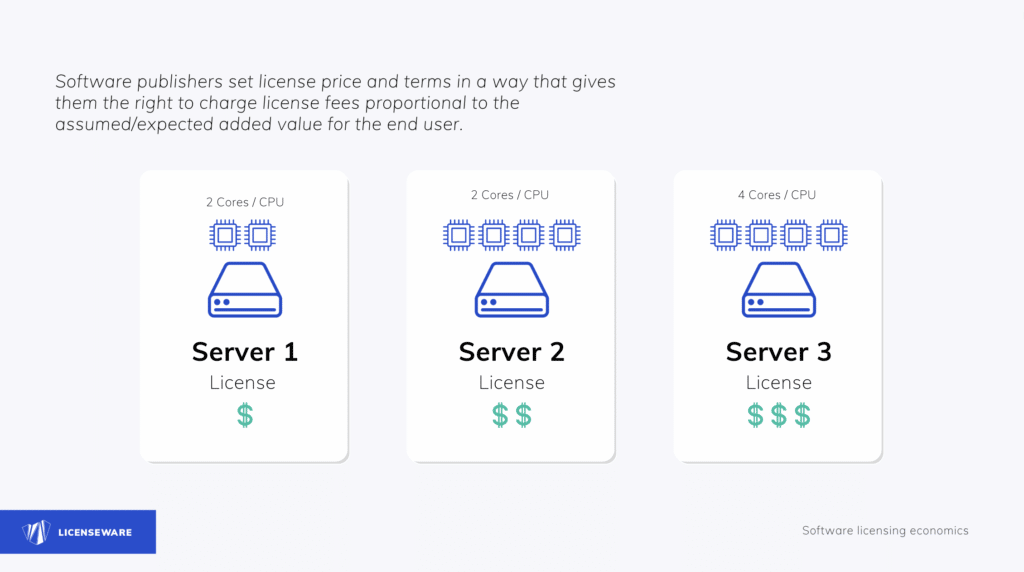
Software publishers set license price and terms in a way that gives them the right to charge license fees proportional to the assumed/expected added value for the end user.
Software vendors typically price their software based on compute power because compute power is a key factor in the performance of their software, especially for software that is heavily reliant on compute power. By pricing their software based on compute power, software vendors can ensure that their customers are paying for the resources they are using, and that organizations that require more compute power are paying more for the software.
This aligns the interests of the software vendors and their customers and ensures that the customer is paying a fair price for the software they are using. In other words, if the customer is using a lot of compute to run the software, it means that the product or services offered have a high demand and therefore the use of the software contributes directly to the value the company is generating. Additionally, pricing based on compute power allows software vendors to offer a flexible pricing model that can be customised to the specific needs of different organisations.
Software license management as an IT practice
Software license management is a critical IT practice that enables organizations to effectively manage and optimize the use of their software assets.
It is important to have visibility into the software licenses that are being used across the organization and to ensure compliance with licensing agreements. It’s also important to have a system in place to track and manage the procurement, deployment and retirement of software licenses. This not only helps with cost savings, but also ensures that the organisation is utilising its resources effectively.
As software licensing becomes mainstream and software audits a common revenue tactic, organisations realise the importance of managing software licenses and integrating these processes as subroutines of IT asset management practices. Thus SAM was born. 🙂
Software Asset Management

Software Asset Management (SAM) is the practice of managing and optimizing the use of software assets within an organization. The history of SAM can be traced back to the early days of software development, when companies began to realize the value of their software assets and the need to manage them effectively.
In the 1980s and 1990s, software asset management focused primarily on compliance with software license agreements, and involved manually tracking the number of software licenses purchased and ensuring that the number of licenses in use did not exceed the number of licenses purchased. This was done mainly through spreadsheets, paper records and physical inventories.
In the late 1990s and early 2000s, with the advent of the internet and software as a service (SaaS) models, software asset management has become more complex and dynamic. Today, software asset management practices often involve automating license tracking and enforcement, and integrating software asset management with other IT practices, such as IT service management and IT financial management.
SAM has become a critical practice for organisations to ensure compliance with software licensing agreements, optimise software costs, and ensure that software assets are being used effectively.
People, Processes and Data
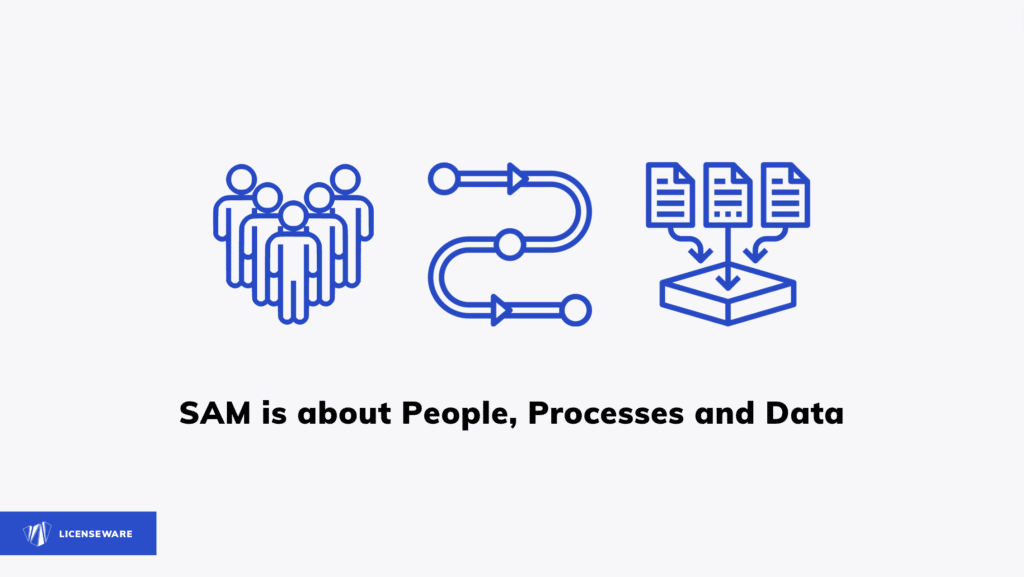
Software Asset Management (SAM) is about people, processes and data because it involves a combination of human expertise, structured processes and accurate data to effectively manage and optimise the use of software assets within an organisation.
SAM requires a team of dedicated and skilled professionals to ensure compliance with software licensing agreements, track and manage software assets, and provide guidance and support to other departments within the organisation. These professionals need to have a deep understanding of software licensing agreements and the software assets being used in the organization, as well as the ability to communicate effectively with different stakeholders.
Secondly, SAM relies on well-defined and structured processes to manage the procurement, deployment, retirement and resale of software assets. This includes processes for identifying and tracking software assets, managing software licenses, and ensuring compliance with licensing agreements. These processes need to be integrated with other IT practices such as IT service management and IT financial management to ensure that the organization is utilizing its resources effectively.
Lastly, SAM requires accurate and up-to-date data on software assets and licenses. This includes information on the number of software licenses purchased, the number of licenses in use, and the location and status of software assets. This data is used to track and manage software assets, ensure compliance with licensing agreements, and make informed decisions about the procurement, deployment and retirement of software assets.
If you find our articles useful, register for our monthly newsletter for regular industry insights 👇
